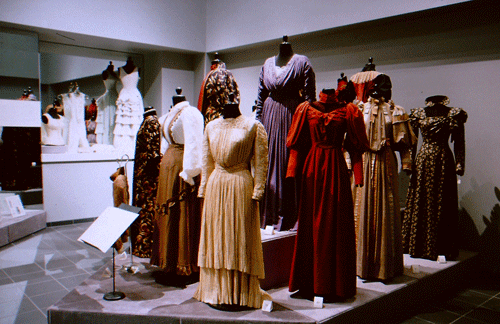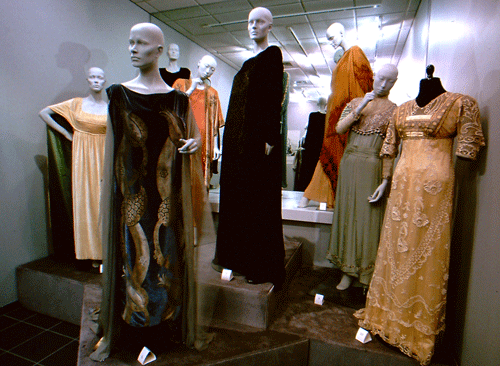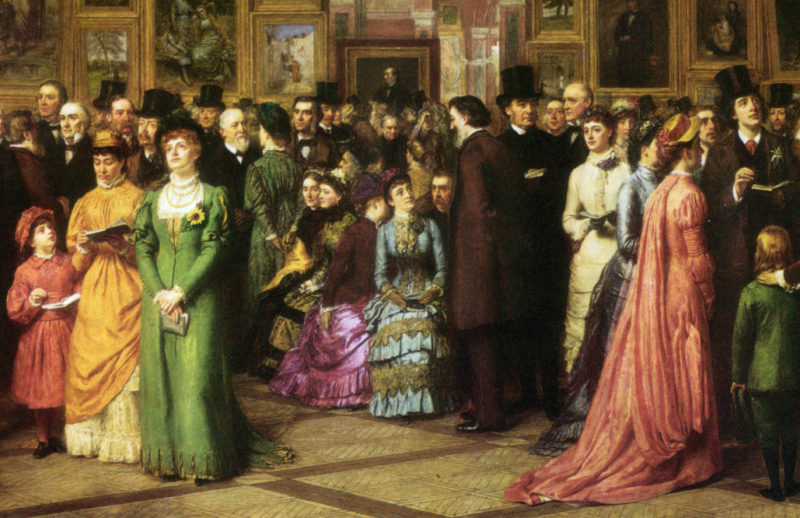Dress Reform – Beyond the Bloomer
Although the bloomer dress did not take off as a fashion in the mid-19th century, dress reform didn’t go away. Women were still seeking social and political equality. The invention of the hoop skirt wasn’t going to change that. Women still participated in sports, and fashion continued to evolve and be influenced by the social changes taking place. Bloomers represented the struggle for equal rights in the public’s eye. Some claim that the ridicule aimed at the wearers of bloomers hurt the struggle more than it helped, as the focus was aimed at pants and not the issues. The initial idea behind wearing of pants and for getting rid of corsets had more to do with health and taste than female emancipation. Neither idea of women wearing pants nor the desire for equality went away when women stopped wearing bloomers.
Artistic Dress Movement
The Artistic Dress movement lasted about 50 years, from around 1850 to 1900. Its tenets favored beautiful materials and simplicity of design. Influenced by the Pre-Raphaelites, Artistic Dress designs were a stark contrast to the lavish styles of mainstream fashions of the day. Fabric colors were muted; coming from natural dyes. Ornamentation was achieved using embroidery. The dresses were loosely-fitted compared to the heavily corseted mainstream fashions. Dresses flowed instead being shaped by petticoats, hoop skirts, and bustles. In many respects, it was an homage to the purity of medieval design and natural beauty, as well as belief in the use of quality materials and handwork.

Photo from a 2000 exhibition on the Dress Reform movement at Ohio State University. Examples of Artistic Dress
Aesthetic Dress Movement
The Aesthetic Dress movement evolved out of the Artistic Dress movement in the 1870s. In addition being influenced by ancient Greek fabric draping methods, it embraced fabrics coming out of the Far East. The emphasis was on beauty, not health. Aesthetic Dress used the body as a canvas upon which the wearer created an individual work of art.

Photo from a 2000 exhibition on Dress Reform at Ohio State University
Aesthetic Dress
Return to Dress Reform
Dress reform returned during the 1870s, picked up steam in the 1880s, and found a receptive atmosphere in the United States by the 1890s due to economic and social changes. The development of the bicycle may have singlehandedly surged the dress reform movement forward. No sport matched the appeal of the bicycle, where the wearing of a split skirt or pants were the logical choice for enjoying the activity. Women were also graduating from college and entering the workforce. Fashion had no choice but to change along with the times.
Dress reform continued into the 20th century. The flapper is a direct offshoot of dress reform. Not only did it represent freedom of movement, it represented the ‘new woman;’ someone who is more than wife and mother. She was her own woman, perhaps for the first time.
In my opinion, dress reform continued through much if not all of the 20th century. Pants were still frowned upon as a way to dress for school when I was a young girl. The older sisters of my friends were the catalyst for change in the 1960s. By the early 1970s, we were allowed to wear pants to school. We certainly weren’t thinking of the origins of those changes back then, but we can all thank the dress reform movement!
Oh, dress reform wasn’t just for women, either. Oscar Wilde was a big proponent of dress reform for both men and women. He believed people should wear whatever they wanted. Oh, Oscar!
Recollections offers a variety of dresses that could be considered reform fashions. Our Victorian Style Cotton Dress is just one example!
– Donna Klein
Resources
Information
Love to Know: Dress Reform
Fashion Era: Rational Dress Reform
Victorian Web: Anti-Fashion, or Victorian Attempts at Reform of Male and Female Dress
Photos
“Reforming Fashion, 1850-1914: Politics, Health, and Art.” Historic Costume Textiles Collection. Ohio State University, 2000. Web. 20 July 2016.












Leave A Comment